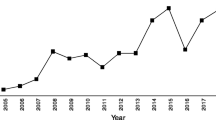Abstract
Many countries support the creation of new firms. Such policy is based on the presumption that the total number of jobs increases when a person moves from unemployment or regular employment to self-employment. In this paper the link between self-employment and overall employment is analyzed. The empirical analysis, based on panel data of Swedish counties from 1976–1995, pays particular attention to simultaneity issues. The results suggest that self-employment may have a significant positive effect on overall employment.
Similar content being viewed by others
References
Acs, Z. J. (ed.), 1996, Small Firms and Economic Growth, Cheltenham: Edward Elgar.
Acs, Z. J., B. Carlsson and C. Karlsson (eds.), 1998, Entrepreneurship, Small and Medium-Sized Enterprises and the Macro Economy, Cambridge University Press.
Anderson, T. W. and C. Hsiao, 1981, ‘Estimation of Dynamic Models with Error Components’, Journal of American Statistical Association 76.
Baumol, W. J., 1990, ‘Entrepreneurship: Productive, Unproductive, and Destructive’, Journal of Political Economy 98(5).
Baumol, W. J., 1993, Entrepreneurship, Management, and the Structure of Payoffs, Cambridge, MA: MIT Press.
Birch, D., 1979, The Job Generation Process. Final Report to Economic Development Administration, Cambridge, MA: MIT Program on Neighborhood and Regional Change.
Blanchflower, D. G. and B. D. Meyer, 1994, ‘A Longitudinal Analysis of the Young Self-employed in Australia and the United States’, Small Business Economics 6(1), 1–19.
Blanchflower, D. G. and A. J. Oswald, Does Access to Capital Help Make an Entrepreneur?, NBER Working Paper, No. 3252, 1991.
Blau, D. M., 1989, ‘A Time-series Analysis of Self-employment in the United States’, Journal of Political Economy 95(3), 445–467.
Calmfors, L., 1994, Active Labour Market Policy and Unemployment - A Framework for the Analysis of Cirucial Design Features. OECD Economic Studies, No. 22, 1994.
Calmfors, L. and P. Skedinger, 1995, ‘Does Active Labourmarket Policy Increase Employment?’, Oxford Review of Economic Policy 11, 91–109.
Crouchley, R., P. Abell, and D. Smeaton, 1994, An Aggregate Time Series Analysis of Non-agricultural Self-employment in the U.K., Discussion Paper No. 209, Centre for Economic Performance, London School of Economics, London.
Davidsson, P., L. Lindmark and C. Olofsson, 1998, ‘The Extent of Overestimation of Small Firm Job Creation - An Empirical Examination of the Regression Bias’, Small Business Economics 11, 87–100.
Davis, S. J., J. Haltiwanger and S. Schuh, 1996a, ‘Small Business and Job Creation: Dissecting the Myth and Reassessing the Facts’, Small Business Economics 8(4), 297–315.
Davis, S. J., J. Haltiwanger and S. Schuh, 1996b, Job Creation and Destruction, Boston, MA: The MIT Press.
Evans, D. S. and B, Jovanovic, 1989, ‘An Estimated Model of Entrepreneurial Choice under Liquidity Constraints’, Journal of Political Economy 97(4).
Fölster, S. and G. Trofimov, G., 1997, Does the Welfare State Discourage Entrepreneurs?, IUI Working Paper.
Grubb D. and Wells, W., Employment regulation and patterns of work in EC countries. OECD Economic Studies, no. 21, 1993.
Holtz-Eatkin, D., D. S. Joulfaian and H. S. Rosen, 1994a, ‘Sticking It Out: Entrepreneurial Survival and Liquidity Constraints’, Journal of Political Economy 102(1), 53–75.
Holtz-Eatkin, D., D. Joulfaian and H. S. Rosen, 1994b, ‘Entrepreneurial Decisions and Liquidity Constraints’, Rand Journal of Economics 25(2), 334–347.
Kihlstrom, R. E. and J. J. Laffont, 1979, A General Equilibrium Entrepreneurial Theory of Firm Foundation Based on Risk Aversion, vol. 87, 719–748.
Knight, F. H., 1921, Risk, Uncertainty and Profit, New York: Houghton Mifflin.
Koskela, E. and M. Virén, 1994, ‘Taxation and Household Saving in Open Economies - Evidence from the Nordic Countries’, Scandinavian Journal of Economics 96(3), 425–441.
Kotlikoff, L. J., 1995, Privatization of Social Security: How It Works and Why It Matters, NBER Working Paper No. 5330.
Laussel, D. and M. Le Breton, 1995, ‘A General Equilibrium Theory of Firm Formation Based on Individual Unobservable Skills’, European Economic Review 39, 1303–1319.
Layard, R., R. Jackman and S. Nickell, 1991, Unemployment, Oxford: Oxford University Press.
Lindh, T. and H. Ohlsson, 1995, ‘Self-employment and Selffinancing’, Economic Journal.
Lindh, T. and H. Ohlsson, 1996, Self-employment and Selffinancing, Department of Economics, Uppsala University, Working Paper.
Lucas, R. Jr., 1978, ‘On the Size Distribution of Business Firms’, Bell Journal of Economics 9, 508–523.
Maddala, G. S., 1977, Econometrics, McGraw Hill International.
Meager, N., 1994, Self-employment Schemes for the Unemployed in the European Community: The Emergence of a New Institution and Its Evaluation, I Schmid, G., red., Labor Market Institutions in Europe - a Socioeconomic evaluation of performance, M.E. Sharpe, New York.
Moore, R. L., 1983, ‘Employer Discrimination: Evidence from Self-employed Workers’, Review of Economics and Statistics 65, 496–501.
Murphy, K. M., A. Schleifer and R. W. Vishny, 1991, ‘The Allocation of Talent: Implications for Growth’, Quarterly Journal of Economics,503–530.
Nickell, S., 1981, ‘Biases in Dynamic Models with Fixed Effects’, Econometrica 49.
OECD Employment Outlook, July 1992, p. 158.
Parker, S. C., 1996, ‘A Time Series Model of Self-employment under Uncertainty’, Economica 63(251), 459–475.
Quadrini, V., Entrepreneurship, Saving and Social Mobility, Mimeo, Department of Economics, University of Pennsylvania.
Rees, H. and A. Shah, 1986, ‘An Empirical Analysis of Selfemployment in the U.K.’, Journal of Applied Econometrics 1, 95–108.
Schumpeter, J. A., 1911, The Theory of Economic Development. Cambridge, MA: Harvard University Press, English translation, 1936.
Storey, D. J., 1994, Understanding the Small Business Sector, New York: Routledge.
Thurik, R., 1999, The Dutch Polder Model: Shifting from the Managed Economy to the Entrepreneurial Economy, Paper presented at AEA meeting in New York, January.
Author information
Authors and Affiliations
Rights and permissions
About this article
Cite this article
Fölster, S. Do Entrepreneurs Create Jobs?. Small Business Economics 14, 137–148 (2000). https://doi.org/10.1023/A:1008141516160
Issue Date:
DOI: https://doi.org/10.1023/A:1008141516160




